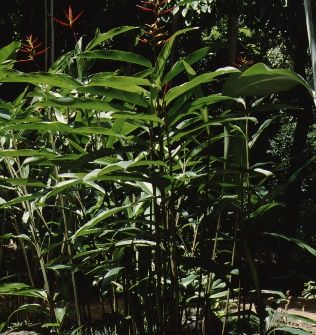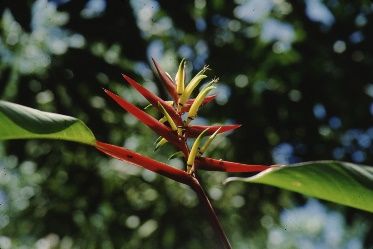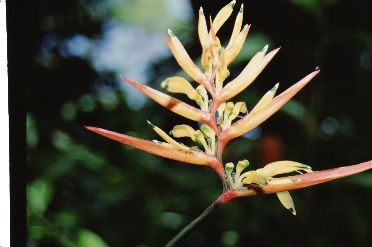Introduction
The many species of heliconia are rainforest herbs that occur within the understory or densely at the forest periphery. A few rapidly colonize temporary tree-fall gaps or occur in the open along streams or in disturbed areas. They range from not much more than 1.5 feet in height to nearly 15 feet tall. The relatively inconspicuous flowers are borne in extravagantly colored bracts that are waxy and long lasting and have become high-priced tropical cut flowers. Some of the species bear pendant inflorescences, and these can be as long as several feet.

Credit: Edward F. Gilman, UF/IFAS

Credit: Edward F. Gilman, UF/IFAS

Credit: Edward F. Gilman, UF/IFAS

Credit: Edward F. Gilman, UF/IFAS
General Information
Scientific name: Heliconia spp.
Pronunciation: hel-lick-KOE-nee-uh species
Common name(s): heliconia
Family: Heliconiaceae
Plant type: herbaceous
USDA hardiness zones: 10B through 11 (Figure 5)
Planting month for zone 10 and 11: year-round
Origin: not native to North America
Invasive potential: not known to be invasive
Uses: cut flowers; suitable for growing indoors
Availability: somewhat available, may have to go out of the region to find the plant

Credit:
Description
Height: 2 to 15 feet
Spread: 3 to 6 feet
Plant habit: upright
Plant density: open
Growth rate: fast
Texture: coarse
Foliage
Leaf arrangement: alternate
Leaf type: simple
Leaf margin: entire
Leaf shape: ovate
Leaf venation: pinnate
Leaf type and persistence: evergreen
Leaf blade length: more than 36 inches
Leaf color: green
Fall color: no fall color change
Fall characteristic: not showy
Flower
Flower color: red; yellow; orange
Flower characteristic: spring flowering; summer flowering
Fruit
Fruit shape: unknown
Fruit length: unknown
Fruit cover: unknown
Fruit color: blue
Fruit characteristic: inconspicuous and not showy
Trunk and Branches
Trunk/bark/branches: typically, multi-trunked or clumping stems
Current year stem/twig color: green
Current year stem/twig thickness: very thick
Culture
Light requirement: plant grows in part shade/part sun
Soil tolerances: acidic; alkaline; sand; loam; clay
Drought tolerance: moderate
Soil salt tolerances: moderate
Plant spacing: 36 to 60 inches
Other
Roots: not applicable
Winter interest: no special winter interest
Outstanding plant: plant has outstanding ornamental features and could be planted more
Pest resistance: very sensitive to one or more pests or diseases which can affect plant health or aesthetics
Use and Management
As landscape plants, many Heliconia species are less desirable because of their spreading nature and the tendency of the leaves to become tattered along the veins by wind. H. psittacorum (to 5 feet tall) and its many hybrids (known as Parakeet Flowers), are frequently used as landscape perennials. However, their aggressive spreading nature requires effective root barriers to keep the rhizomes from extending into areas where the plant is not wanted. H. caribaea, well-adapted to alkaline soils, is a tall-grower (to 12 feet) with deep red-bracted inflorescences borne on 2-year-old stems. The many varieties of H. stricta rarely grow taller than 3 feet. Heliconias as a group impart an unmistakable tropical look to the garden. Heliconias can be used as specimen plants, or they can be massed together in groups.
Heliconia species should be grown in full sun to partial shade on a well-drained soil. These perennials have no drought or salt tolerance but will endure wet soils. When these plants are occasionally frozen in the warm parts of Florida, the tops will die back to the ground, but roots will regenerate new shoots with the coming of warm weather.
Propagate the Heliconia species by division.
Pests and Management
These species are relatively pest tolerant.